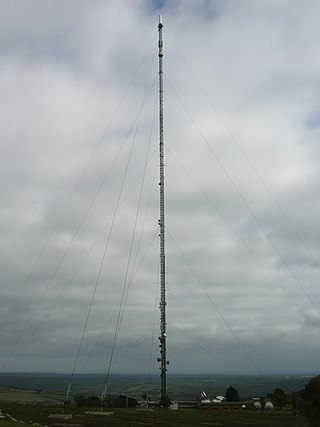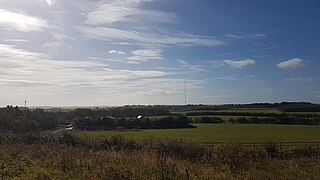Bermuda has three main television stations, a small cable microwave system, three public GSM services, multiple submarine cables, and two main Internet service providers.

Very high frequency (VHF) is the ITU designation for the range of radio frequency electromagnetic waves from 30 to 300 megahertz (MHz), with corresponding wavelengths of ten meters to one meter. Frequencies immediately below VHF are denoted high frequency (HF), and the next higher frequencies are known as ultra high frequency (UHF).

The FM broadcast band is a range of radio frequencies used for FM broadcasting by radio stations. The range of frequencies used differs between different parts of the world. In Europe and Africa and in Australia and New Zealand, it spans from 87.5 to 108 megahertz (MHz) - also known as VHF Band II - while in the Americas it ranges from 88 to 108 MHz. The FM broadcast band in Japan uses 76 to 95 MHz, and in Brazil, 76 to 108 MHz. The International Radio and Television Organisation (OIRT) band in Eastern Europe is from 65.9 to 74.0 MHz, although these countries now primarily use the 87.5 to 108 MHz band, as in the case of Russia. Some other countries have already discontinued the OIRT band and have changed to the 87.5 to 108 MHz band.

The Crystal Palace transmitting station, officially known as Arqiva Crystal Palace, is a broadcasting and telecommunications site in the Crystal Palace area of the London Borough of Bromley, England. It is located on the site of the former television station and transmitter operated by John Logie Baird from 1933.
The Sutton Coldfield transmitting station is a broadcasting and telecommunications facility located in Sutton Coldfield, Birmingham, England. In terms of population covered, it is the third most important transmitter in the UK, after Crystal Palace in London and Winter Hill near Bolton.
The following tables show the frequencies assigned to broadcast television channels in various regions of the world, along with the ITU letter designator for the system used. The frequencies shown are for the analogue video and audio carriers. The channel itself occupies several megahertz of bandwidth. For example, North American channel 1 occupies the spectrum from 44 to 50 MHz. See Broadcast television systems for a table of signal characteristics, including bandwidth, by ITU letter designator.

FM broadcasting is a method of radio broadcasting that uses frequency modulation (FM) of the radio broadcast carrier wave. Invented in 1933 by American engineer Edwin Armstrong, wide-band FM is used worldwide to transmit high-fidelity sound over broadcast radio. FM broadcasting offers higher fidelity—more accurate reproduction of the original program sound—than other broadcasting techniques, such as AM broadcasting. It is also less susceptible to common forms of interference, having less static and popping sounds than are often heard on AM. Therefore, FM is used for most broadcasts of music and general audio. FM radio stations use the very high frequency range of radio frequencies.
A television transmitter is a transmitter that is used for terrestrial (over-the-air) television broadcasting. It is an electronic device that radiates radio waves that carry a video signal representing moving images, along with a synchronized audio channel, which is received by television receivers belonging to a public audience, which display the image on a screen. A television transmitter, together with the broadcast studio which originates the content, is called a television station. Television transmitters must be licensed by governments, and are restricted to a certain frequency channel and power level. They transmit on frequency channels in the VHF and UHF bands. Since radio waves of these frequencies travel by line of sight, they are limited by the horizon to reception distances of 40–60 miles depending on the height of transmitter station.
The Llanddona transmitting station is a broadcasting and telecommunications facility, situated at Llanddona, near Beaumaris, on the isle of Anglesey, Wales. It comprises a 106.7 metres (350 ft) guyed mast with antennas attached at various heights. It is owned and operated by Arqiva.

The Wenvoe transmitting station, officially known as Arqiva Wenvoe, is the main facility for broadcasting and telecommunications for South Wales and the West Country. It is situated close to the village of Wenvoe in the Vale of Glamorgan, Wales, in the UK.

ZBM-TV is a television station in Hamilton, Bermuda, serving the British territory as an affiliate of CBS. It is owned by the Bermuda Broadcasting Company alongside ABC affiliate ZFB-TV. The two stations share studios on Fort Hill Road in Devonshire Parish.

ZFB-TV is a television station in Hamilton, Bermuda, serving the British territory as an affiliate of ABC. It is owned by the Bermuda Broadcasting Company alongside CBS affiliate ZBM-TV. The two stations share studios on Fort Hill Road in Devonshire Parish.

The Preseli transmitting station is a broadcasting and telecommunications facility on the eastern end of the Preseli Mountains, close to the villages of Crymych and Pentre Galar in Pembrokeshire, Wales. It is owned and operated by Arqiva.
The Oxford transmitting station is a broadcasting and telecommunications facility, situated on land 129.5 metres (425 ft) above Ordnance Datum to the north east of the city of Oxford, in Oxfordshire, England. It has a guyed steel lattice mast which is 154.4 metres (507 ft) in height to the top of the main steel structure. The UHF television antenna, which consist of a vertical array of transmitting panels, is mounted above the steel structure. The total height of the mast to the top of this UHF antenna is 165.7 metres (544 ft). It is owned and operated by Arqiva.

The Haverfordwest transmitting station is a broadcasting and telecommunications facility located at Woodstock about 13 km (8 mi) to the north east of the town of Haverfordwest, in Pembrokeshire, Wales. It was originally built by the BBC, entering service in early 1964 acting as a main transmitter for the 405-line VHF television system, and as a repeater for Band 2 VHF FM radio received off-air from Blaenplwyf transmitting station. It is now owned and operated by Arqiva.

CCIR System B was the 625-line VHF analog broadcast television system which at its peak was adopted by more than one hundred countries, either with PAL or SECAM colour. It is usually associated with CCIR System G for UHF broadcasts.

The Burnhope transmitting station is a television transmitter in the north of England.

The Blaenplwyf transmitting station is a broadcasting and telecommunications facility located near the village of Blaenplwyf about 10 kilometres (6 mi) to the south west of the town of Aberystwyth, in Ceredigion, Wales. It was originally built by the BBC, entering service in October 1956 acting as a main transmitter for BBC Band II VHF FM radio.

The Kilvey Hill transmitting station was originally built at the summit of Kilvey Hill in Swansea, Wales, by the BBC in 1967 as a relay for VHF and UHF television. VHF television came on air a few months before the UHF services. As built, the station did not radiate VHF FM radio, this was added later. Currently, the hill's transmitters cater for viewers and listeners in the Swansea and Neath Port Talbot area. The transmission station located on top of Kilvey Hill is owned and operated by Arqiva.













